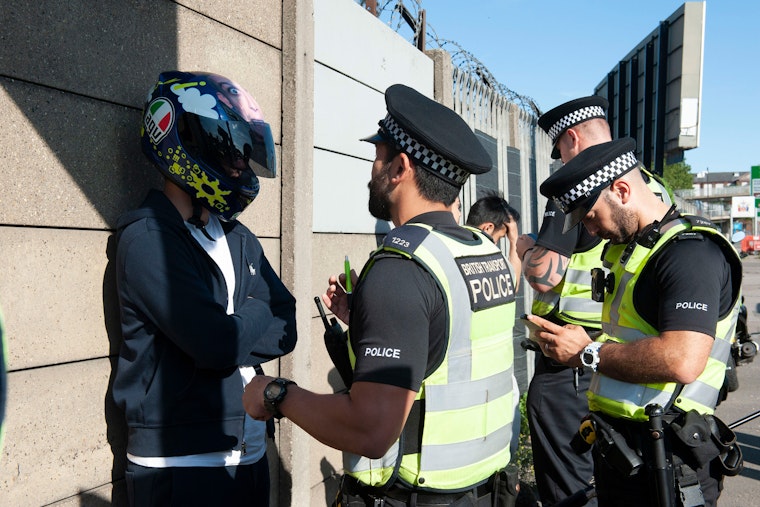Ending Racial Bias in Police Stop and Search
By Rebekah Delsol

In April 2014, Prime Minister Theresa May (who was home secretary at the time) voiced what many of us have known to be true for decades: Stop and search is both discriminatory and ineffective at fighting crime.
May announced major reforms to improve the regulation and oversight of stop and search practices in England and Wales. This included the introduction of a “best use of stop and search” [PDF] scheme to improve standards, national training for all police officers including a module on implicit bias, and annual inspections by Her Majesty’s Inspectorate of Constabulary. May argued that this comprehensive package of reform would “contribute to a significant reduction in the overall use of stop and search” while also providing “better and more intelligence-led stop and search and improved stop-to-arrest ratios.”
She was right: The last four years have seen striking changes to the police use of stop and search. The overall numbers have reduced sharply, to the lowest level in 15 years, and there has been sustained improvement in the quality of grounds (the reasons given for conducting searches) recorded by officers, as well as a marked increase in the arrest rate resulting from stop-searches.
But when it comes to racial disproportionality—May’s ostensible reason for introducing the reforms in the first place—the situation has become worse. And as a new report, The Colour of Injustice: ‘Race’, drugs and law enforcement in England and Wales [PDF] highlights, reductions in the overall use of stop and search have been accompanied by greater concentration on low-level drug offenses and black and minority groups.
Even though black people use drugs at a lower rate than white people, black people are now stopped and searched at a rate of nine times that of white people for drugs. This is a significant increase from the 2010 figures, where black people were stopped and searched at six times the rate of white people for drugs. For 2016–2017, every police force in England and Wales stopped and searched black people at a higher rate than white people.
The problem of disproportionality is no longer simply a matter of who is stopped and searched. Black people are treated more harshly when they are found in possession of stolen and prohibited articles including drugs. The detection rate from stop and search is similar for all ethnic groups, but black people are arrested at a higher rate than whites and given less serious out-of-court disposals (such as fines) at much lower rates. The number of arrests for drugs as a result of stop and search fell by 52 percent for white people between 2010–11 and 2016–17 but did not fall at all for black people.
The report shows that cannabis possession is driving much of the racial disparity in the prosecution and sentencing of drug offenses. Black and Asian people were convicted of cannabis possession at 11.8 and 2.4 times the rate of white people in 2017 despite their lower rates of self-reported cannabis use. More black people were prosecuted for cannabis possession than the supply of Class A or B substances combined whereas the reverse is true for white people. Black people made up over a quarter of those convicted of cannabis possession even though they comprise less than four percent of the population in England and Wales.
It’s scarcely believable that reforms, which were meant to address racial disparities are actually making them worse. So, what explains the failure of these reforms?
With the exception of the brief focus on unconscious bias in national training, none of the reforms directly address the mechanisms that are driving disparities in stop and search. The centerpiece of the reforms, the much-lauded best use of stop and search scheme, focused on compliance with national regulations, barely mentioning ethnic disproportionality and putting nothing in place to address it.
The national College of Policing training program on stop and search, which included a focus on unconscious bias, was rushed and poorly designed. An independent evaluation [PDF] of the training found some small positive effects on officers’ knowledge and attitudes, but little change to their stop and search practices; and the national roll-out of training to all officers has not prevented an escalation in disproportionality. This is broadly in line with research findings, which suggest that changes in implicit bias do not necessarily produce changes in behavior.
Ill-designed reforms have been coupled with police resistance and political point-scoring. Senior police officers and politicians have exploited concerns about rising violent crime to call for greater stop and search powers and an increase in the numbers. Research has repeatedly shown, however, that stop and search has little impact on knife crime and serious violence. A far more likely outcome than increased safety and decreased crime would be the further criminalization of black communities for low-level drug offenses that are largely ignored when perpetrated by other groups.
Simply put, racial disproportionality in stop and search will only be tackled effectively when there is the political will to identifying key drivers of disparities and put specific measures in place to combat them. This means addressing the selective enforcement of drug laws, the over-policing of areas with large black and minority ethnic populations, officer discretion creating the potential for ethnic profiling, and the differential outcomes resulting from stop and searches.

Until November 2021, Rebekah Delsol was a senior team manager at the Open Society Justice Initiative.
